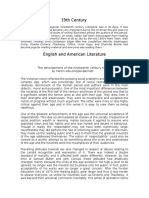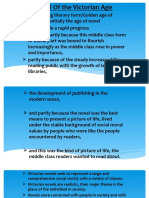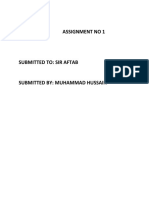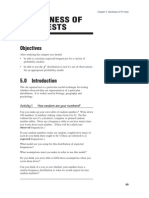The Novel
The Novel
Uploaded by
nesumaCopyright:
Available Formats
The Novel
The Novel
Uploaded by
nesumaCopyright
Available Formats
Share this document
Did you find this document useful?
Is this content inappropriate?
Copyright:
Available Formats
The Novel
The Novel
Uploaded by
nesumaCopyright:
Available Formats
The Novel
The Novel and other forms The germ of the novel lay in medieval romance, a fantastic tale of love and adventure, itself derived from the ballads and the fragments of epic poems sung by the wandering minstrel The term gradually came to signify a story in prose as distinguished from a story in verse. It is a very effective medium for the portrayal of human thought and action. Its Structure A novel has a plot, and to a great extent its characters reveal themselves and their intentions in dialogue. Story need not be symmetrical in exposition, crisis and denouncement. The novel has, no rigid framework, and authors have taken full advantage of the freedom this affords them. The modern novel has the tendency to subordinate action to psychology, to find the central theme in the mental and spiritual development of the characters rather than their physical adventures. As regards the local or regional setting, certain authors have almost marked out a territory of their own. It might also be possible to classify them to a certain extent by social setting.
Purpose and Teaching Every serious novel is sure to reveal the authors own view of life and its problems .In modern fiction we do not expect the author to interrupt his story from time to time and appear in his own person too point out the moral of the situation and justify or deplore the conduct of his characters. Any lesson the novelist wishes to teach is all the more impressive if it emerges from the story itself and the fortunes of its characters. In the hands of a writer of any skill, the effect may be tremendous. The Novel has firmly established itself as the most effective medium for social criticism and diagnosis.
Brief History : Beginnings
Several of the Elizabethans wrote prose works of fiction in a form related to that of the Novel.
Eighteenth Century Several literary development reached their climax in the first half of the eighteenth century and it was then that Novel acquired its modern form. The eighteenth- century novel, though firmly established by Richardson, was further developed by Henry Fielding, Smollett, and Sterne, who all helped to popularize it as a form. Among the later novelists, Oliver Goldsmith deserves special mention for his brilliant studies in character and also for the easy intimate style which became a model for domestic fiction.
Nineteenth Century The nineteenth century saw the process of refinement carried a step further. Jane Austen affected the character of the novel by discarding a sensationalism which had come in the last half of the eighteenth century. Sir Walter Scott inaugurated the historical novel. His primary aim was to tell the story with all the picturesque details. With Charles Dickens, the Novel enters a new phase in its history. He was almost the first to evolve a more complex plot. He often incorporates the painful experiences of his youth his novels. He was supreme, as a painter of individual portraits. Humour and pathos and a deep sympathy for human nature colour his work. He used fiction as a platform for social reform by means of an absorbing story. Thackeray excelled in the novel of ideas, in which the plot is subordinated to the philosophy of life. His chief weapon was irony, and like other authors of his day he was not afraid to drive home a lesson even if he had to interrupt the action of the story. George Elliot widened the scope of the Novel to include the philosophical dissertations on current topics, particularly those dealing with religion, politics, and the social conventions. George Meredith is a satirist with a reformers purpose. Thomas Hardy has little in common with Meredith in either outlook or method. His characters are from the farmers and peasantry, and some of the gentlefolk. He had the art of revealing the innermost soul of his characters without doing violence in his narrative. The Novel took many new directions during the century. The political and social novel was practised by Charles Kingsley, Benjamin Disraeli and Anthony Trollope.
The novel of adventure and exploration was popularised by Sir Henry Rider Haggard and Sir Robert Louis Stevenson. The most important of the late Victorian Novelists, is Henry James, and with him, the emphasis is upon the manners and conventions of a narrow section of society. The Present Time The rapid changes caused by the two World Wars in social conditions have accelerated the development of the Novel. The leading Edwardians used traditional methods. But with the Georgians- It was a time of deliberate and conscious innovations, changed both the style and content of the Novel. The Edwardians were interested in portraying the external world as being revolutionised by the new discoveries of Science and the social changes .Georgians are , on the whole, more interested in exploring the subconscious recesses of the human mind. During the Last fifty years the scope of the Novel has widened to include every subject. It has to become a world influence through films and translations, and has become the most popular medium through which an author can reach an increasingly literate public.
The Novel in the Twentieth Century The anti-Romantic, anti-Victorian attitudes that provided an impetus to the modern movement in poetry had an equally energising effect on fiction. In the eighteenth and nineteenth centuries the Novel has been a public instrument focussing on what was significant to society as whole. The disappearance of all coherence in the early decades of the century due to social and political movements and upheavals was further compounded by the impact of the First World War. Other factors that influenced the redefinition of the novel relate to the contemporary vision of life and reality. The psychological theories of Freud and Jung also affected the technique of the Novel. Their theories showed that objective science can describe the irrational depths of man. These theories also affected point of view- an aspect of practical concern to the novelist. Point of view relates to the narrative mode established by the author to present characters and events. The most telling effect of the emphasis on consciousness was to shift the location of reality from external, social circumstances to the individual consciousness. The novels of Henry James (1843-1916) and Joseph Conrad (1857-1854) although worlds apart in terms of theme and content serve as the earliest indicators of change in fiction writing. Joseph Conrad turns his back on London drawing rooms and upper middleclass
society to bring us a whiff of the salt sea and distant lands through his novels. Books like Lord Jim (1900) In contrast to the interest in the hidden realities of the deep hearts core evinced by James and Conrad, a concern with the world of external realities, distinguishes the writings of Arnold Bennett (1867-1931) and H.G. Wells. The tradition of the realistic novel was continued by John Galsworthy in The Forsyte Saga, a series of four novels that appeared in the 1920s and that chronicles the fortunes of the Forsyte dynasty from Victorian times to modern years and the impact of political changes and advancement in technology on the life-style of the family. A variety of influences shaped James Joyces development as an artist, as perhaps the most authoritative and complex writer among the modernists. Dubliners is a collection of short stories providing the vignettes of Irish life. Ulysses is a more complete embodiment of the art for arts sake ideal that Joyce encountered earlier and elaborated in A Portrait. Joyces linguistic experiments are carried to the furthest limit in Finnegans Wake. Certainly the literary experiments of the writers of the Twenties make increasing demands on the reader. Virginia Woolfs novels are also meant for a diminishing audience of refined sensibilities, the select few who can understand what newness in fiction is all about. The stylistic boldness of Joyce and Woolf is matched by the daring of another sort by D.H. Lawrence. Lawrence rejected the cerebral experimentation of the times and emphasised instead the importance of an instinctual approach to the business of the novel writing The experimental tendencies of 1920s and 1930s seemed to have exhausted themselves by the end of the Second World War. Graham Greenes writing career, almost exactly contemporaneous with Waughs, yielded a different kind of novelistic fare. The swing towards realism is further confirmed by the works of L.P.Hartley, C.P.Snow and Anthony Powell. The contribution of Joyce Cary to realistic trend is no less important. The anti-intellectual stance was proclaimed more aggressively by writers of The Movement who also belong to the 1950s. The experimental tendency, however reasserts itself in the works of Lawrence Durrell and William Golding to provide a more substantial contribution to fiction. Goldings novels The Lord of the Flies, 1954; Pincher Martin , 1956 restore fable to a place in English fiction. The post-war years also saw a number of publications by women writers. The examples of Muriel Spark, Iris Murdoch and Margaret Drabble will go to show the futility of attempting to attach a single descriptive label to women writers. Sparks is a highly original talent, that has affiliations with both the wit of Waugh and the vision of Greene.
Iris Murdochs also has the recourse of the improbable and fantastic in her novels. This makes the reader unsure of the level of reality in her novels. In contrast to Murdochs intellectual interests, Doris Lessing brings to the fore a preoccupation rooted in earthy social realities. The feminist theme is central to Margaret Drabble. Other Feminist writers who command interest are Edna OBrien, Elizabeth Bown, A.S. Byatt and Penelpe Mortimer- to name only a few. They have written about the real grievances of women with lucidity.
You might also like
- MISIC - Manual EdtDocument20 pagesMISIC - Manual Edtnesuma89% (36)
- The Rise of English NovelDocument8 pagesThe Rise of English NovelMJ86% (7)
- Modernism in LiteratureDocument6 pagesModernism in LiteratureMuhammad Hussain100% (7)
- Epq RDocument26 pagesEpq Rnesuma100% (5)
- Saed Jamil Shahwan: The Impact of Social Media On LiteratureDocument20 pagesSaed Jamil Shahwan: The Impact of Social Media On Literaturesohaib ShahwanNo ratings yet
- Fowles vs. DickensDocument4 pagesFowles vs. Dickensboier_motocNo ratings yet
- APA Code of Ethics in TestingDocument2 pagesAPA Code of Ethics in Testingnesuma100% (4)
- Neisse RDocument1 pageNeisse RnesumaNo ratings yet
- Jam Jim Jam PlanDocument7 pagesJam Jim Jam PlangrgNo ratings yet
- 19th CenturyDocument8 pages19th CenturyRaquel GonzalezNo ratings yet
- SEM 2 Rise of Prose FictionDocument3 pagesSEM 2 Rise of Prose FictionMamta SharmaNo ratings yet
- English AssignmentDocument4 pagesEnglish AssignmentHaseeb MalikNo ratings yet
- Novel As A GenreDocument5 pagesNovel As A GenreRhythm SinghNo ratings yet
- AssignmentDocument5 pagesAssignmentnailahassan014No ratings yet
- Realism, Naturalisl, SymbolismDocument4 pagesRealism, Naturalisl, SymbolismFaisal JahangeerNo ratings yet
- UNIT 4 Literatura Inglesa UNEDDocument15 pagesUNIT 4 Literatura Inglesa UNEDErika LoNo ratings yet
- Novel of The Victorian AgeDocument29 pagesNovel of The Victorian AgeShabir RahimoonNo ratings yet
- A Survey of Augustan LiteratureDocument2 pagesA Survey of Augustan LiteratureSAMUELE VERDENo ratings yet
- Trace The Development of The English NovelDocument7 pagesTrace The Development of The English NovelAbdulrahman RadeefNo ratings yet
- TheriseofthenovelDocument27 pagesTheriseofthenovelMazhar CheemaNo ratings yet
- Types of NovelsDocument6 pagesTypes of NovelsRangothri Sreenivasa SubramanyamNo ratings yet
- Introduction - Recent Theories of NarrativeDocument5 pagesIntroduction - Recent Theories of NarrativeUday RoteNo ratings yet
- Realism PDFDocument3 pagesRealism PDFBrianNo ratings yet
- Women and Victorian Literature: Daise Lílian Fonseca DiasDocument17 pagesWomen and Victorian Literature: Daise Lílian Fonseca DiasJunee BanerjieNo ratings yet
- The Eighteenth Century and The Rise of T PDFDocument4 pagesThe Eighteenth Century and The Rise of T PDFANKUR ARYANo ratings yet
- English NovelDocument4 pagesEnglish NovelRhema F.E. OgucheNo ratings yet
- Ernest HemingwayDocument12 pagesErnest HemingwayAndrei GalbenuNo ratings yet
- AssignmentDocument6 pagesAssignmentMuhammad HussainNo ratings yet
- ModernDocument8 pagesModernPranabesh DasNo ratings yet
- Written Report ModernismDocument6 pagesWritten Report ModernismRodelyn SoledadNo ratings yet
- Victorian PoetryDocument2 pagesVictorian PoetryMaddalena TintiNo ratings yet
- Postmodern Literature Is A Type of Literature That Came To Prominence After World War IIDocument9 pagesPostmodern Literature Is A Type of Literature That Came To Prominence After World War IIАлександр ЧечулинNo ratings yet
- Modern Psychological NovelDocument4 pagesModern Psychological Novel41Pratibhu BhattacharjeeNo ratings yet
- Jelicina SkriptaDocument138 pagesJelicina SkriptaindiraNo ratings yet
- A Literary Voyage Into The Unconscious: A Philosophical Approach To The Psychological Novel in Woolf's Mrs. Dalloway (1925)Document10 pagesA Literary Voyage Into The Unconscious: A Philosophical Approach To The Psychological Novel in Woolf's Mrs. Dalloway (1925)Muhammad IbrahimNo ratings yet
- The Victorian NovelDocument7 pagesThe Victorian Novelayyy lmaoNo ratings yet
- Novel: The Eighteenth Century and The Rise of The English Novel (Mariwan N. Hasan)Document145 pagesNovel: The Eighteenth Century and The Rise of The English Novel (Mariwan N. Hasan)zohaib husnainNo ratings yet
- The NovelDocument29 pagesThe NovelA stupid called SammyNo ratings yet
- 306 Victorian Novelists Essay 1Document5 pages306 Victorian Novelists Essay 1JenishNo ratings yet
- INTRODUCTIONDocument4 pagesINTRODUCTIONzyzz3690No ratings yet
- 1st Term The Great GatesbyDocument7 pages1st Term The Great GatesbysaidNo ratings yet
- BS English Semester IV Course 205 Lecture 1: Realism & Naturalism I. Realism (1861-1940)Document13 pagesBS English Semester IV Course 205 Lecture 1: Realism & Naturalism I. Realism (1861-1940)Wajeeha MehmoodNo ratings yet
- Understanding FictionDocument5 pagesUnderstanding Fictionphamkimnhung12102001No ratings yet
- Chapter III 1Document8 pagesChapter III 1Adina TudorNo ratings yet
- The Age of NovelDocument14 pagesThe Age of NovelAseel AbushyNo ratings yet
- The Rise of The NovelDocument6 pagesThe Rise of The Novelsumy venkatNo ratings yet
- What Is Novel.Document79 pagesWhat Is Novel.bariscem100% (1)
- The LiteratureDocument7 pagesThe Literaturefokin avocadoNo ratings yet
- The Rise of The English NovelDocument11 pagesThe Rise of The English NovelShowket IbraheemNo ratings yet
- Karakoram International University: TopicDocument56 pagesKarakoram International University: TopicNoor KhanNo ratings yet
- SEA Literature Module 5Document11 pagesSEA Literature Module 5Hazel AcebronNo ratings yet
- The First Half of The 20Th Century Poetrty: Georgian PoetryDocument13 pagesThe First Half of The 20Th Century Poetrty: Georgian PoetryGiorgia SalemiNo ratings yet
- The 19th Century NovelDocument6 pagesThe 19th Century NovelKimYot100% (3)
- BEGC-133 ENGLISH GUESS PAPER LATEST.pdfDocument23 pagesBEGC-133 ENGLISH GUESS PAPER LATEST.pdfanuraggsharmaa56No ratings yet
- Conlit GRP.12 DemoDocument5 pagesConlit GRP.12 Demoroseanndoblas2223No ratings yet
- Prose and Fiction - English Helping HandDocument19 pagesProse and Fiction - English Helping Handajaymohan022No ratings yet
- The 20th Century To Contemporary PeriodDocument54 pagesThe 20th Century To Contemporary PeriodJoyce FlorescaNo ratings yet
- Introduction To NOVEL: Appreciation of English LiteratureDocument14 pagesIntroduction To NOVEL: Appreciation of English LiteratureSHINENo ratings yet
- Brief Introduction To 20th Century Novel and ProseDocument23 pagesBrief Introduction To 20th Century Novel and ProseneelakbatooolNo ratings yet
- VanHocANH MYDocument9 pagesVanHocANH MYnguyennguyen31095No ratings yet
- Masters of the English Novel: A Study of Principles and PersonalitiesFrom EverandMasters of the English Novel: A Study of Principles and PersonalitiesNo ratings yet
- w3-reviewerDocument2 pagesw3-reviewerkyllaprincess38No ratings yet
- The Victorian AgeDocument8 pagesThe Victorian Agefrancescacardamone05No ratings yet
- Issues and Challenges in Emerging LiteratureDocument8 pagesIssues and Challenges in Emerging Literaturestclarecollege.froilantinduganNo ratings yet
- Short-StoriesFrom EverandShort-StoriesL. A. PittengerNo ratings yet
- SDT Material PDFDocument15 pagesSDT Material PDFnesumaNo ratings yet
- LD-Practice Guidelines - India 2011 PDFDocument48 pagesLD-Practice Guidelines - India 2011 PDFnesuma100% (2)
- Dep + AnxDocument10 pagesDep + AnxnesumaNo ratings yet
- Gregory - History of Psychological TestingDocument28 pagesGregory - History of Psychological TestingnesumaNo ratings yet
- Socratic QuestionsDocument5 pagesSocratic QuestionsnesumaNo ratings yet
- Neuro Test 1Document2 pagesNeuro Test 1nesumaNo ratings yet
- HELPING OTHERS HelpingAttitudesScaleDocument4 pagesHELPING OTHERS HelpingAttitudesScalenesuma0% (1)
- Building Better CommunitiesDocument20 pagesBuilding Better CommunitiesnesumaNo ratings yet
- Chapter 02-Projective TestsDocument48 pagesChapter 02-Projective Testsnesuma100% (2)
- 16pf PersonalityDocument25 pages16pf PersonalitydiasjonaNo ratings yet
- Sentence Completion TestsDocument14 pagesSentence Completion TestsDoina Albescu60% (5)
- Neuro Test - Unit 1Document2 pagesNeuro Test - Unit 1nesuma100% (2)
- HSPQ ResearchDocument187 pagesHSPQ ResearchnesumaNo ratings yet
- ChiDocument26 pagesChiAbhinav RamariaNo ratings yet
- Personality Dynamics - An Integrrative Approach To AdjustmentDocument456 pagesPersonality Dynamics - An Integrrative Approach To AdjustmentnesumaNo ratings yet
- Mental Health ActDocument75 pagesMental Health ActnesumaNo ratings yet
- Dap ManualDocument31 pagesDap Manualnesuma100% (1)
- VrttaratnakaraDocument56 pagesVrttaratnakaraBoram LeeNo ratings yet
- 21st Century Literature-Applying ICT On LiteratureDocument25 pages21st Century Literature-Applying ICT On LiteratureLetecia Agnes100% (1)
- Edexcel IGCSE English Literature Coursework 2014Document9 pagesEdexcel IGCSE English Literature Coursework 2014sonal116No ratings yet
- BSEd3ENG LIT.1 CHAPTER5 WORD REPORTFDocument13 pagesBSEd3ENG LIT.1 CHAPTER5 WORD REPORTFAnaliza A IglesiasNo ratings yet
- Shiva Trilogy - EvaluationDocument5 pagesShiva Trilogy - EvaluationCdr Varma75% (4)
- The Oxford Handbook of John Bunyan Oxford Handbooks Michael Davies All Chapters Instant DownloadDocument47 pagesThe Oxford Handbook of John Bunyan Oxford Handbooks Michael Davies All Chapters Instant DownloadezinsaharNo ratings yet
- Divisions of LiteratureDocument42 pagesDivisions of LiteraturePauLine JimTacey Winters100% (1)
- The Analysis On Segment A Land Supra Segment AlDocument8 pagesThe Analysis On Segment A Land Supra Segment AlNOR-ALI SOUDNo ratings yet
- Download full Heinrich Von Kleist Artistic and Political Legacies 1st Edition Jeffrey L. High ebook all chaptersDocument71 pagesDownload full Heinrich Von Kleist Artistic and Political Legacies 1st Edition Jeffrey L. High ebook all chaptersashwalpulung100% (12)
- Debate On Traditional and Crippled (Simplified) Chinese CharactersDocument15 pagesDebate On Traditional and Crippled (Simplified) Chinese Charactersprefect447449No ratings yet
- A Simple Analysis of The Covid-19 PoemsDocument33 pagesA Simple Analysis of The Covid-19 Poemsvictoradedoyin.pcNo ratings yet
- Curriculum Map: English 7Document10 pagesCurriculum Map: English 7Nerie ToneteNo ratings yet
- KarumanchiweddingDocument1 pageKarumanchiweddingS SreenivasuluNo ratings yet
- What Tolkien Officially Said About Elf SexDocument5 pagesWhat Tolkien Officially Said About Elf Sexthe_doom_dudeNo ratings yet
- Academic Writing ConventionsDocument24 pagesAcademic Writing Conventionsa.u.sumithrarachchiNo ratings yet
- Drama 3 Ways People Respond To Drama Inquiry 2checkedbymoiraDocument3 pagesDrama 3 Ways People Respond To Drama Inquiry 2checkedbymoiraapi-238218223No ratings yet
- Practice Test 3Document3 pagesPractice Test 3Pham Thu HaNo ratings yet
- The Lion The Witch and The Wardrobe Lesson Plan PDFDocument4 pagesThe Lion The Witch and The Wardrobe Lesson Plan PDFTwogunkid100% (1)
- Solutions 3e Level 3 Literature Worksheet 5 2Document2 pagesSolutions 3e Level 3 Literature Worksheet 5 2Levent DemirelNo ratings yet
- Analisi Oread Da LeggereDocument2 pagesAnalisi Oread Da LeggereOliver MellorsNo ratings yet
- The Idea of Europe in Literature: Prof Coord.: Ovidiu Pecican Creator: Mladin Elisa-MariaDocument10 pagesThe Idea of Europe in Literature: Prof Coord.: Ovidiu Pecican Creator: Mladin Elisa-MariaCălin ManițiuNo ratings yet
- Reg June 15 PDFDocument5 pagesReg June 15 PDFHetal JadavNo ratings yet
- Phil LitDocument34 pagesPhil LitRachelle Dela RosaNo ratings yet
- English Literature: Insight ReportDocument12 pagesEnglish Literature: Insight ReportAbdelrahman TabashNo ratings yet
- Book of Wise Sayings: PrefaceDocument123 pagesBook of Wise Sayings: PrefaceGutenberg.orgNo ratings yet
- The Rape of The Lock: Alexander PopeDocument18 pagesThe Rape of The Lock: Alexander PopeMohammad Ekramul Islam Khan (182013005)No ratings yet
- CartiDocument4 pagesCartiSimona-Maria Cornea100% (1)
- Daffodils 10 IcseDocument2 pagesDaffodils 10 Icsemedhaviagarwal2No ratings yet














































































































